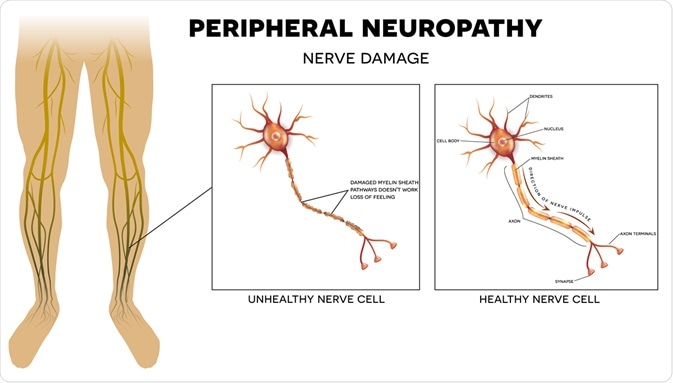Peripheral neuropathy is a painful condition caused by damage to the nerves of the peripheral nervous system. Peripheral neuropathy is a fairly prevalent condition, affecting over 15 million people in the United States and Europe alone.

Image Credit: Tefi
The incidence of peripheral neuropathy increases with age; estimates indicate that peripheral neuropathy affects 2% of the population overall, but this number rises to 8% in people aged 55 years and older.
There are three types of peripheral nerves, and damage can occur to all types. Sensory nerves transmit sensations of temperature, touch, pain, and vibration from the extremities to the brain. Motor nerves are responsible for voluntary movements and transmit signals from the brain to the skeletal muscles. Autonomic nerves regulate involuntary activities such as heart rate, blood pressure, breathing rate, and digestion.
There are more than 100 known types of peripheral neuropathies, and the types are classified by considering the number of affected nerves and the localization of symptoms.
Damage can occur to a single nerve, called mononeuropathy, or to multiple individual nerves, called mononeuritis multiplex.
Some types of neuropathies affect all nerves and are termed polyneuropathies. If the effects of peripheral neuropathy are localized to a particular body region, it is considered a focal neuropathy, while symptoms on both sides of the body from widespread nerve damage are considered generalized polyneuropathies.
Peripheral neuropathy: Mayo Clinic Radio
Generalized Polyneuropathy
Generalized polyneuropathies are the most common forms of neuropathies, and within this classification, diabetic neuropathy is by far the most prevalent. Approximately 30% of all neuropathies are caused by diabetes.
The World Health Organization estimates that 150 million people worldwide suffer from a form of diabetes, and of them, nearly 50% experience symptoms of diabetic neuropathy.
A recent study of diabetic patients in Europe concluded that diabetic neuropathy negatively impacted patient work productivity, general functioning, and health-related quality of life while resulting in high healthcare costs. Because of this, proper management of diabetes and its associated neuropathy is critical for minimizing the economic and human impact of this condition.
In addition to diabetes, other underlying causes of generalized neuropathies include medication toxicity, such as exposure to certain anti-retroviral or chemotherapeutic agents; diseases that result in damage to the protective myelin sheath that covers each nerve (demyelination), such as Guillain-Barre Syndrome; alcoholism, which damages nerve function; and genetic mutations that affect myelin protein production, such as Charcot-Marie-Tooth disorder.
Focal Mononeuropathies
Focal neuropathies affect an individual nerve or localized regions of the body. This type of neuropathy is commonly caused by physical trauma such as that incurred from a motor vehicle accident or by repetitive motion injuries. One commonly occurring focal neuropathy is carpal tunnel syndrome.
Repetitive motions of the wrist and lower forearm result in inflammation and swelling of the tendons surrounding the median nerve, resulting in tingling, numbness, burning, and pain due to compression of the nerve as it proceeds through the carpel tunnel.
Carpal tunnel syndrome is a temporary disorder that can be alleviated with rest along with medications to decrease pain, strengthening exercises, or sometimes surgery. A similar form of nerve compression can occur with the ulna nerve at the elbow.
Additional examples of focal neuropathies include sciatica, post-traumatic neuralgia, and phantom limb pain.
Further Reading